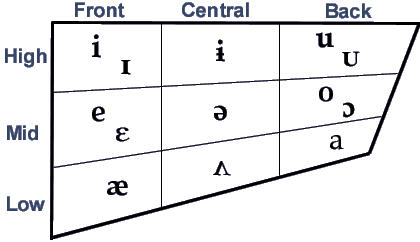| Linguistics 105 * Words and Sounds |
| Lecture Number Three |
| Introduction to Phonetics |
- Phonetics and Phonology: The Sounds &
Sound Systems of Language
- Questions:
- What is the relation between spelling and linguistic sounds?
(Remember the example of ghoti, "fish," from laugh, women, nation (George Bernard Shaw).)
- How are the following pronounced?
bough [baw]
cough [kØf]
dough [do]
hiccough [hikÏp]
thorough [ÊÏrÏ]
through [Êru]
tough [tÏf] - Others:
bass [bes], [bÀs] low frequency/fish bow [bo], [baw] shoots arrows/front of the boat buffet [bÏfe], [bÏfêt] food spread/wind-blown close [kloz], [klos] to shut/near coax [koks], [kowÀks] urge/shielded cable desert [dizrt], [dêzrt] abandon/Sahara do [du], [do] to act/do re mi does [dÏz]. [doz] acts/several female deer dove [dÏv], [dov] bird/did dive Some more - Remember: in linguistics, [lêtr] is a 4-letter word!
In this course we only discuss sounds and signs for only
about 1/3 of the world's 5,000 languages have writing systems.
- How are the following pronounced?
- Ambiguity: how do we avoid it?
- Rim ember us poke in cent tense all mow stall ways con deigns word snot in ten did
- Not "boundaries" as on the page, although some boundaries exist. (Some are different from others.)
- We do not merely receive sounds, we actively perceive
them.
- What is the relation between spelling and linguistic sounds?
- "Perception" is a set of expectations to which we actively match incoming
signals
- Flexible
 --
i.e. we are interpreting abstractions, types, not tokens (although
these terms are tricky).
--
i.e. we are interpreting abstractions, types, not tokens (although
these terms are tricky).
- Vary with context.
- This "perception"
is grounded in "phonology."
- Flexible
- Phonetics. The first step is a system of universal, cross-linguistic
notation without reference to a specific alphabet or language
- Language is primarily a spoken system, not a written one. (Only about 1/3 of 5,000+ languages have writing systems.
- Phonetics represents sound at the token, not type, level
- Rule of phonetics: one sound-- one symbol -- no matter how small the distinction, whether it is linguistically significant or not.
- Questions:
- The
Phonetic Alphabet
- The English Phonemes
- The
Natural Classes of Consonants (Saggital
Section)
English Consonants Bilabial Labial DentalAlveolarPalatalVelarGlottalStops
Voiced b d… d g Voiceless p t… t k ´ Aspirated pß tß kß Fricatives Voiced v ö z — g Voiceless f q s Œ x h Affricates Voiced ” Voiceless “ Sonorants Nasal m n h Liquid r,l Glide w j
- The
Natural Classes of Vowels (Sagittal
Section)

- The
Natural Classes of Consonants (Saggital
Section)
- Some other phonetic conventions
- nasalization [›, ‹, õ,
Æ]
- aspiration [p‘ b‘ t‘ d‘ k‘ g‘]
- palatals [û, ÿ],
- Palatal affricates (delayed release): put the upside-down hat (called a wedge), as seen on s and z above, on top of c (=“) and j (=”)
- nasalization [›, ‹, õ,
Æ]
- Some surprising examples:
Some Unexpected Examples nation [neŒn] catch [kæ“] fish [føŒ] picture [pøk“r] fission [fø—n] tree [“ri] trouble [“rÏbå] did you [dø”u] pretty [prøDi] bottle [ba´tl] talk [tÍk] which/witch [Åø“ /wø“] - Examples for practice.
Print these examples out and transliterate them from or to phonetic script for practive.-
-
A Few More Examples [lÐn—íre] __________ [rezr] __________ [ajdÏv] __________ [”i“êk] __________ [wõ“u] __________ [dø”Ïgêdøm] __________
-
- The English Phonemes
- Conclusion
The International Phonetic Alphabet is designed to represent distinctive linguistic sounds on a one-one basis, one sound associated with one symbol, to avoid the ambiguities associated with writing systems.
|
|
|
|
|
|
|
|
|
|
|